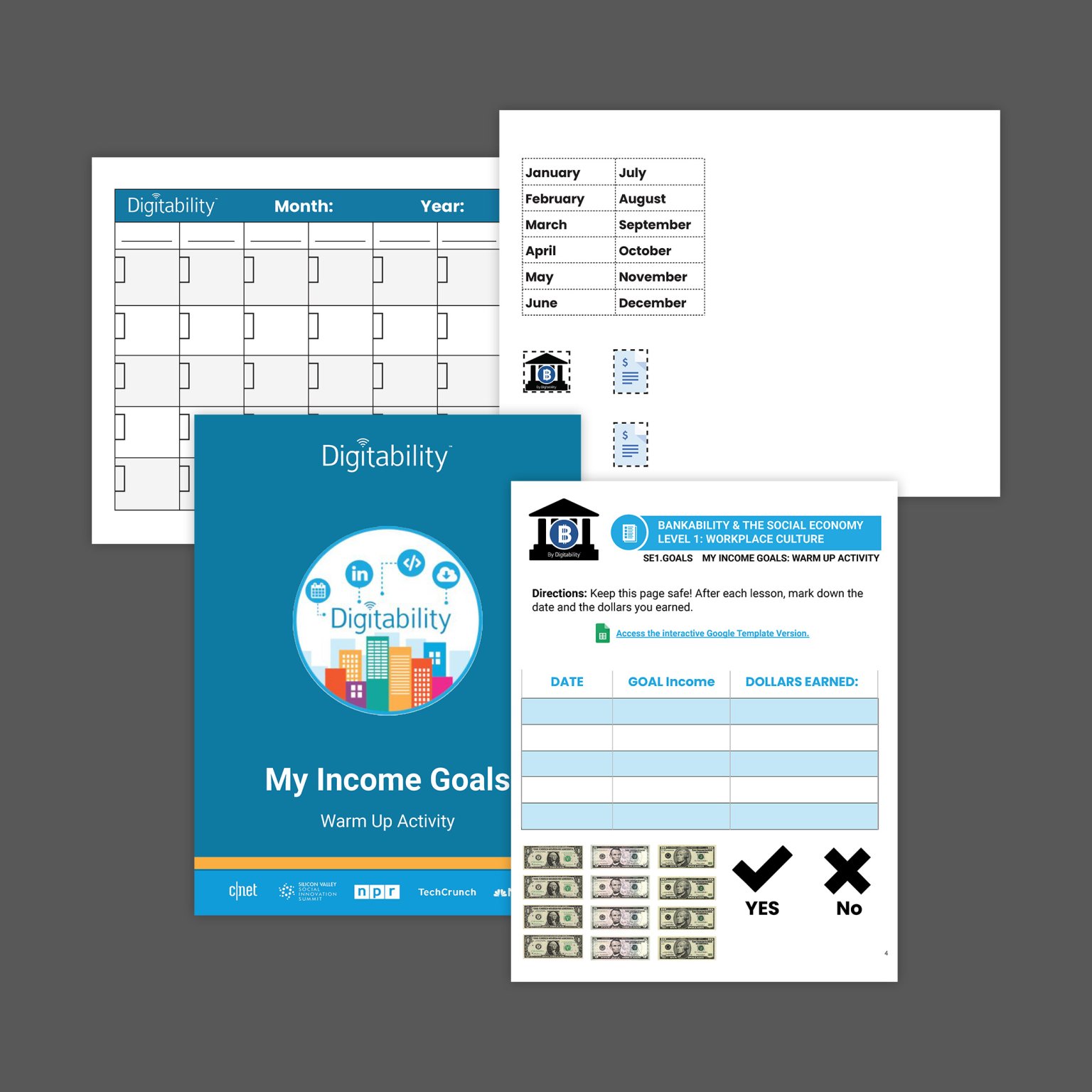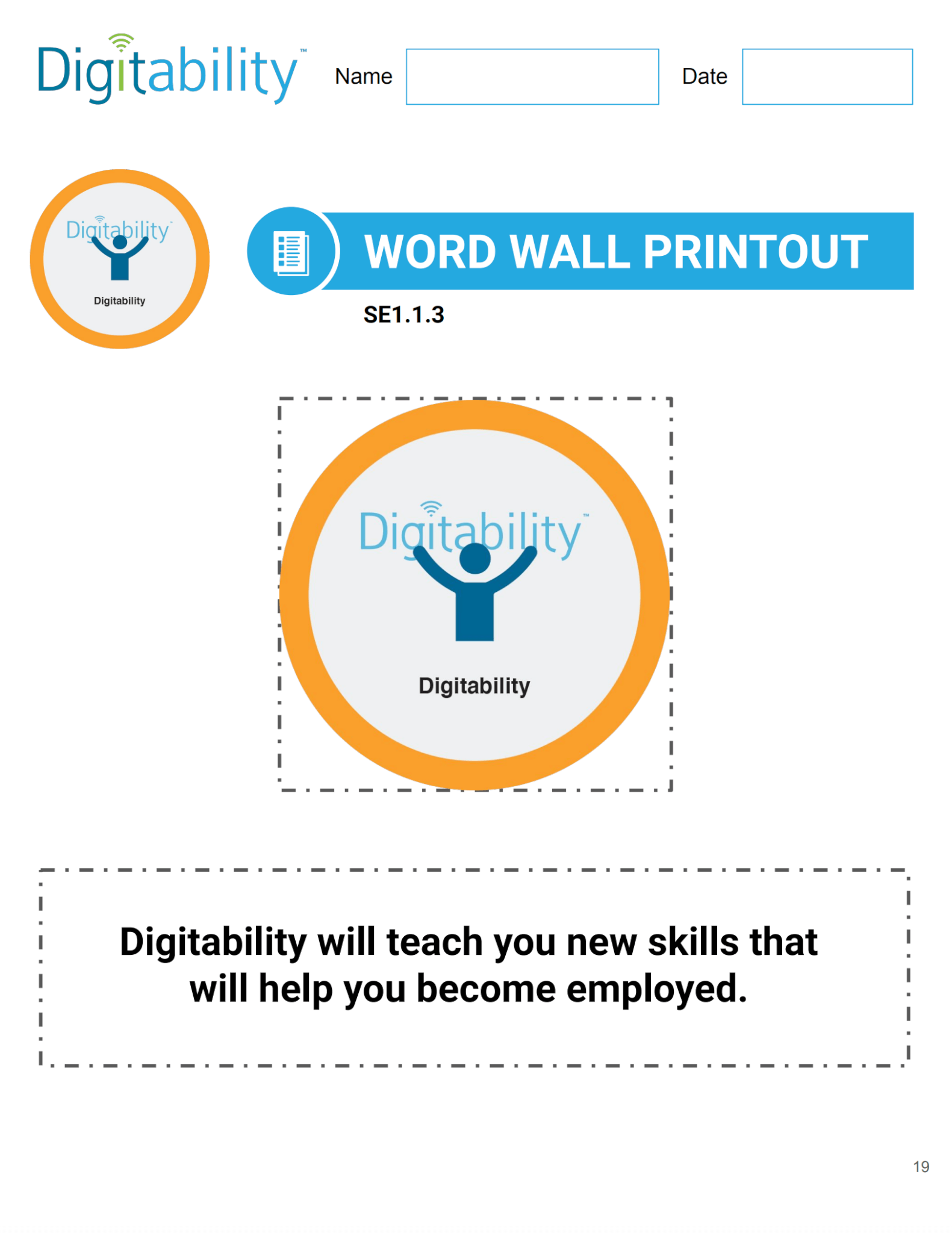Modifying Instruction During Guided Watching

No Two Students are the Same; Neither are their IEP Goals
Each student requires something different when it comes to their list of IEP goals. Every day teachers are charged with finding ways to engage, support, motivate and differentiate for each of their students.
Digitability has organized strategies for streamline evidence-based practices for any given classroom with a wide-range of student needs including varying cognitive abilities, expressive and receptive language, self-regulation skills, and age-appropriate behavior. It’s a tall order for life skills teachers to manage.
Get Your FREE Quote Today!
Overview of the Guided Watching
Each lesson is anchored in a lesson video that will provide students with the vocabulary and concepts that will be used through the rest of the lesson. During the lesson videos teachers can differentiate to ensure that all students are meaningfully included in the lesson.
Throughout the facilitation of the lesson’s Guided Watching, teachers should strive to have all students actively engaged in the lesson video. In order to achieve this, teachers use the Thumbs Up engagement strategy. The Thumbs Up strategy is when a teacher tasks all students with giving a thumbs up every time they hear the key vocabulary word for that lesson in the lesson video.
The teacher will preface the lesson video by saying “Let’s watch this training video. I know that (Student Name) is actively watching because he has his eyes on the screen. When you hear the word ‘(key vocabulary term)’ give me a thumbs up and I’ll add Participation Dollars.” This lets students know that the expectation is to give a thumbs up when they hear the key word, and that they will earn Participation Dollars for doing so. This motivates students to participate and demonstrate task attendance and engagement.
Before playing the video, the teacher may find it helpful to model and practice the Thumbs Up engagement strategy. The teacher could say “Before we start, let’s practice. The key word is internet. Every time you hear me say the word internet, put a thumbs up.” Then, the teacher can talk and use the word internet multiple times. Each time they say it, the teacher should model giving a thumbs up themselves. As they are modeling how to do it, they should also use Positive Narration to bring attention to students who are following the directions. This could look like “I see that both Drew and Abbey heard me say the word internet and followed directions by giving a thumbs up! Who else is following directions and giving a thumbs up when they hear me say the word internet?”
While the video is playing, it may be easier for teachers to track the dollars that students earn on the Dollar Earnings Tracker, rather than handing out physical dollars. Handing out physical dollars and providing the verbal feedback with them can become distracting from the content of the video.
Meet the Student Personas
Note: The following personas are meant to illustrate a range of cognitive, communicative and behavioral needs for a wide-range of learning styles. These personas were created to help teachers identify the characteristics and associated strategies for their students needs.

Advanced Tier 1 Student: Drew can read, write, and comprehend paragraphs. Academically, he is one year below grade level. He is reinforced by getting time to use his phone during school. Drew has low motivation to complete assignments. He has difficulty with self-regulation and responsible decision making. He also has difficulty with impulse control. Drew is charismatic and his peers are drawn to him, giving him the potential to be a leader.

Tier 1 Student: Marcus can speak in 2-3 sentences and is able to read and comprehend paragraphs. He is reinforced by watching videos on Youtube. Marcus’ behaviors that impede learning include interrupting and complaining. He consistently is helpful with other students in the class and is a strong problem solver.

Tier 2 Student: Abbey can speak in 4-5 word utterances, and she is able to read with little comprehension. Abbey is reinforced by listening to music. She has some behaviors that interfere with learning, such as making off topic comments and teasing others. Abbey tends to perseverate on fairies and princesses, which contributes to her off topic comments. However, Abbey is an active participant in lessons and frequently shares with her peers.

Tier 3 Student: Jonathan is primarily nonverbal, he uses a communication device inconsistently, and knows some signs. He is not yet reading and has limited listening comprehension. Jonathan is reinforced by playing computer games. He demonstrates behaviors that interfere with learning, such as aggressive behavior and not following directions. However, Jonathan consistently greets others and likes to participate in lessons.
Strategies for an Advanced Tier 1 Student

Advanced Tier 1 Student:
Functional Academics: Can read, write, and comprehend paragraphs; Academically, he is one year below grade level.
Language: Age-appropriate
Reinforcers: Time to use his phone during school
Behavior: Low motivation to complete assignments. Difficulty with self-regulation and difficulty with impulse control.
Strengths: Charismatic and his peers are drawn to him, giving him the potential to be a leader.
During the Guided Watching: The teacher will tell the class "When you hear the word 'internet,' give a thumbs up and I'll add Participation Dollars." While the video is playing, Drew may not follow directions to give a thumbs up when he hears the word internet. He may make a comment such as “I am not doing this"
Strategies for Addressing Not Following Directions
- Instead of interrupting the video to redirect Drew, the teacher can use Positive Narration and draw attention to a student who is following directions and the command. “I see that Jonathan gave a thumbs up when he heard the key word. I’m marking down Jonathan’s Participation Dollar! Who else is earning Participation Dollars?"
- If Positive Narration is not effective, then the teacher can address Drew more directly to engage him in the activity. "Drew, I know you like to use your dollars to buy time on your phone. I’m marking down your dollars when you give a thumbs up during the video.”
- The teacher can also stand in close proximity to Drew and model giving a thumbs up while the video is playing. Standing near him and modeling the strategy will serve as a prompt for Drew to engage in the video himself.

- As Drew engages in the thumbs up strategy, the teacher should mark down his dollars using the Dollars Earning Tracker while providing immediate feedback using the embedded Digitability language formulas.
repeat the answer + describe the behavior + deliver consequence
"I see that Drew gave a thumbs up when he heard the word Internet. I’m marking down Drew’s Participation Dollar!"
- In Level 2 of Digitability's Workplace Behavior Unit, students will identify and practice both the behaviors that will support their success in the workplace, as well as those behaviors that can be perceived as problematic. In these lesson plans, Digitability will explicitly explain how complaining impacts the workplace and depict strategies for developing self-regulation skills and a self-advocacy plan. In this level of Digitability, the teacher can utilize the Social Economy to assign a $1 fee for complaining to help Drew analyze the frequency of this behavior and strengthen his strategies for self-regulation. To learn more, contact our team.

- What is an Extinction Burst? It is important to understand that with some interventions the behaviors may seem to increase in frequency, intensity or duration before they begin to decrease. This is called an extinction burst. Evidence-based practices embedded in Digitability's Social Economy are tools that should be used consistently in order to be effective. It won't be a one-and-done solution!
Strategies for a Tier 1 Student

Tier 1 Student:
Functional Academics: Can read and comprehend paragraphs
Language: Can speak in 2-3 sentences
Reinforcers: Watching videos on Youtube
Behavior: Interrupting and Complaining
Strengths: Consistently helpful with other students, strong problem solver
During the Guided Watching: The teacher will tell the class "When you hear the word 'internet,' give a thumbs up and I'll add Participation Dollars." Marcus may begin to engage in the thumbs up strategy. However, while the video is playing, Marcus may interrupt and talk over the video. He might say “I use the internet to watch Youtube with my brother!”
Strategies for Addressing Interrupting
- The teacher can provide a verbal reminder of the expectations. “Marcus, remember, we are giving a quiet thumbs up so that we can hear the video.”
- If the interruption serves the function of gaining attention, the teacher should limit attention to Marcus and provide prompts to remain on task.

The teacher can also show Marcus a visual prompt to remind him of the behavior expectations. This could be a visual showing a quiet voice and thumbs up.

A gesture prompt can also be provided, which would include the teacher making the quiet sign, with a finger over their lips.
- As Marcus engages in the thumbs up strategy, the teacher should mark down his dollars on the Dollars Earning Tracker while providing immediate feedback using the embedded Digitability language formulas.
repeat the answer + describe the behavior + deliver consequence
"I see that Marcus gave a thumbs up when he heard the word Internet. I’m marking down Marcus’s Participation Dollar!"
- In Level 2 of Digitability's Workplace Behavior Unit, students will identify and practice more behaviors in the workplace that will support their success in the workplace as well as those behaviors that can be perceived as problematic. In these lesson plans, Digitability will explicitly explain how complaining impacts the workplace and strategies for developing self-regulation skills and self-advocacy plans for the workplace. To learn more, contact our team.
Strategies for a Tier 2 Student

Tier 2 Student:
Functional Academics: Can read with little comprehension, some writing skills, low IQ
Language: Speaks in 4-5 word utterances
Reinforcers: Listening to music
Behavior: Making off-topic comments due to perseverating on fairies and princesses, teasing others
Strengths: Actively participates in lessons, frequently shares with peers
During the Guided Watching: The teacher will tell the class "When you hear the word 'internet,' give a thumbs up and I'll add Participation Dollars." Abbey may not initially begin to engage in the thumbs up engagement strategy. While the video is playing, Abbey may start to make off topic comments such as “Princesses are my favorite!”
Strategies for Addressing Off Topic Comments
- The teacher can provide a verbal reminder to Abbey by saying, “Abbey, remember it is time to listen to the video. We need to give a quiet thumbs up when we hear the word internet. When you do that I’ll track a Participation Dollar for you!”
- The teacher can also use Positive Narration to redirect Abbey’s comments. The teacher can say “I see Drew giving a thumbs up when he hears our vocabulary word, Drew is earning Participation Dollars. I’m marking down dollars when you give a quiet thumbs up.”
- The teacher can also provide visual and gestural reminders to Abbey, by showing her the quiet voice signal, with a finger over lips, and model the quiet thumbs up as the video is playing.
- Once Abbey demonstrates the thumbs up strategy without making off -topic comments, the teacher should mark down the Participation Dollars for Abbey while providing immediate feedback using the embedded Digitability language formulas.
repeat the answer + describe the behavior + deliver consequence
"I see that Abbey gave a thumbs up when she heard the word Internet. I’m marking down Abbey’s Participation Dollar!"
- In Level 2 of Digitability's Workplace Behavior Unit, students will identify and practice more behaviors in the workplace that will support their success in the workplace as well as those behaviors that can be perceived as problematic. In these lesson plans, Digitability will explicitly explain how complaining impacts the workplace and strategies for developing self-regulation skills and self-advocacy plans for the workplace. To learn more, contact our team.
Strategies for a Tier 3 Student

Tier 3 Student:
Functional Academics: Not yet reading, limited listening comprehension, low IQ
Language: Primarily nonverbal, uses a communication device inconsistently, knows some signs
Reinforcers: Playing computer games
Behavior: Aggressive behavior, not following directions
Strengths: Consistently greets other, enjoys participating in lessons
During the Guided Watching: The teacher will tell the class "When you hear the word 'internet,' give a thumbs up and I'll add Participation Dollars." While the lesson video is playing, Jonathan does not engage in the Thumbs Up strategy initially. Instead, he reaches over to the student next to him and pinches him.
Strategies for Addressing Aggressive Behavior
- As the teacher sees Jonathan engage in aggressive behavior, the teacher should maintain a neutral tone and facial expression, in order to not draw too much attention toward the behavior.
- The teacher should remind Jonathan of the behaviors his must exhibit to earn reinforcement using positive language. This means the teacher should tell Jonathan what the expected behavior is, not telling him what not to do. "Jonathan, you need to have a safe body and keep your hands to yourself to earn dollars. For Participation Dollars, you need to give a thumbs up when you hear the word internet in the video."
- The teacher can provide a visual prompt by giving Jonathan a picture of the vocabulary word, or the corresponding badge. This will cue Jonathan to engage when he hears that word said on the video.
- The teacher can also provide a model prompt by standing by him and saying “When the video says the word internet, give a thumbs up, show me,” while the teacher also gives a thumbs up.
- If Jonathan continues to have difficulty with engaging in the strategy, the teacher can provide a partial physical prompt by giving him a light tap on the hand as a cue to give a thumbs up.
- If Jonathan does not provide a response still, the teacher can provide a full physical prompt by putting their hand over Jonathan’s hand and manipulating his fingers into a thumbs up.


- Once Jonathan does engage in the strategy, after prompting, the teacher should mark down his dollars on the Dollars Earning Tracker while providing immediate feedback using the embedded Digitability language formulas.
repeat the answer + describe the behavior + deliver consequence
"I see that Jonathan gave a thumbs up when she heard the word Internet. I’m marking down Jonathan’s Participation Dollar!"
- In Level 2 of Digitability's Workplace Behavior Unit, students will identify and practice more behaviors in the workplace that will support their success in the workplace as well as those behaviors that can be perceived as problematic. In these lesson plans, Digitability will explicitly explain how complaining impacts the workplace and strategies for developing self-regulation skills and self-advocacy plans for the workplace. To learn more, contact our team.
If you need additional resources or assistance in differentiation, reach out to your coach!




